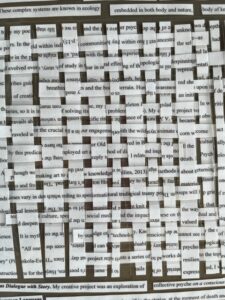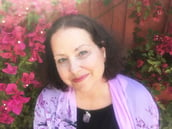Artist in Residence for the M.A. Depth Psychology and Creativity with Emphasis in the Arts and Humanities program (DCH), Pamela Brown is an artist and poet who takes inspiration from the desert of Southern Utah. I’m delighted to speak with her about her art, Pacifica, and her residency.
Angela Borda: You graduated from the DCH program, so let’s start there. Please tell us a little about what led you to DCH and the affect the program had on you.

Pamela Brown: I studied English and anthropology as an undergrad, and creative writing was always part of my life. My partner and I own a bookstore and coffee shop, which I’ve done for a few decades now. I found myself reading and ordering and being drawn to books of Jungian writing. I kept accidently reading books by Pacifica graduates, and I couldn’t throw a stone without reading Marion Woodman, Robert Johnson, or Carl Jung. I looked into different grad schools and considered a Ph.D. in Cultural Anthropology, but I longed for something deeper, something that addressed the ‘why’ of human culture. It was all about the psyche for me. There was a Jungian society that met behind my bookstore, and three separate people from it asked me if I’d considered Pacifica for graduate school. So I visited, drove to the ocean, and I knew I would attend.
Pacifica changed my life. I know that sounds cliché, but going to Pacifica was a gesturing to myself, right after Covid, having worked 10 years, to answer the urgent call and to do what mattered. The way the program is structured, I could be creative and do art, but it’s not an M.F.A., so I wasn’t focusing on craft but the impetus behind the creativity. I got to look into some of the ideas of anthropology but through a different lens, which is that we come making offerings for a reason, and I wanted to explore what that reason was, what was under my art.
Angela: I’m excited to introduce the “artist in residence” position to those Pacifica students who may not know about it. The Artist in Residence position is seated in the DCH program, and as Chair Mary A. Wood describes it, the position “was originated by poet Joel Weishaus, who retired from Pacifica in 2023. Over many years, Joel offered valuable, confidential mentoring of DCH students regarding their creative projects both in and out of their classes, and their lives as creative individuals.” You are following, then, in Joel’s footsteps as the 2024-2026 Artist in Residence. What do you consider to be your primary role in terms of advising students? What kinds of interactions do you have with them?
Pamela: I find meetings with students to be very organic and natural. The structure is that I’m available for 30-minute zoom meetings. Some students need workshopping of their work, some people just need to talk about their ideas. I’ve been keeping track of the questions people ask, and some are deeper, like “Is it worth it? Is there anything to my work?” For me as a student, Joel had committed to a sustained set of years doing art as activism, as something spiritual. His work was genius and I was in awe of him. He was someone who would be on campus during residential sessions meals, so I asked him about my work, about dialoguing with the desert. We had a short interaction, but I knew he was a way-shower, that he’d been where I wanted to go. So with students it’s been a mutually inspiring experience. Some students send me their poetry, some want to touch base for encouragement. Any medium. However they come, we discuss the impulse beneath the making.
Angela: Aside from the advising and mentoring role, you are also creating your own body of work during your two-year term (2024-2026), which you will then share during your time here. What kind of work are you focusing on and what form will sharing it take?

Pamela: My goal is to have a publishable manuscript and/or a book. I’m combining words and images. I’m drawn to the petroglyphs lining the rock walls of the desert, and I want to make a book that features petroglyphs on the rock, and the shapes they make. I want to make a book of poetry as ancient peoples would draw on cave walls; poetry as visual art, sculpture in conjunction with the landscape. I’m writing on walls, essentially, like every ancient human since the dawn of time.
Angela: Mary A. Wood has said that your work is influenced by your background in symbolic anthropology and depth psychology. Can you tell us more about that? I know that the desert and petroglyphs feature prominently in your art.
Pamela: A lot of my work is influenced by David Abram, author of Spell of the Sensuous. He has talked about ancient people reading the landscape in the way we read language. Symbolic anthropology is an examination of the shapes and symbols and the associations we have with them. I’ve been interested in the ways that cultures conceptualize their world according to systems of symbols. I would always hear about something being “anthropological” or “Archetypal” and “sourced in the psyche.” I somehow ended up studying what it is to be human and a part of creation in schools that called it different things: depth psychology, the collective unconscious, indigenous dreaming, ecopsychology. It seemed like I was studying the same thing: What does it mean to be a creative person who is trying to tend to the world and contribute something?
Angela: How does poetry figure into your creative expression? Have you always done written word and art pieces in tandem? Do words access something different in us than images?
Pamela: I really like this question! Poetry has a lot of layers, and it’s also sounds. Some of my poetry is to rhythm and needs to be spoken. I’m cognizant of poetry as an image, the language on the page is an image, and so a lot of my work is trying to return poetry to its origins, which is making marks on the landscape that symbolize something deeper. I never considered myself just a poet, I’ve always combined image, sound, and language. The letters are shapes that are used to depict the things they express. I’m so obsessed with language. We used to be very connected to the landscape because our language reflected what we were speaking of, then we transitioned to a purely human language.
Angela: This holiday season, Pacifica will be reflecting on our core values, one of which is “Service,” which is about honoring and serving what is unique within ourselves, within those in our community, and the larger world. As an artist and poet who is currently doing both (attending to your own unique art and being of service to others in our community and world), I wondered if you would speak about the core value of “service” as it relates to art in particular, and the effect that can have on our world.
Pamela: In terms of service, I have yet to find something that feels like it has a greater impact than art. It’s a subtle and sacred activism, I connect it to ceremony. Prehistoric people groups gathered and held each other, and it’s so important to bring forth what feels instinctual and give it away. Art doesn’t originate from me, it comes through me as a force of creation. The best thing anyone can do is be a clear channel for any message that needs to come through. It’s the balance of the ecology of a species trying to survive, that we each come with something to give. It’s all we can do.
Angela: Do you have anything upcoming that you’d like to share with us?
Pamela: I am looking forward to spending a sustained period of time in the desert over December. When I am silent among the rocks and layers of vast geology, it inspires me to co-create, to observe creative forces at work and rock formations that took thousands of years to form. It puts human creativity in perspective, as part of a timeless contribution.
Angela: Thank you so much for your service to Pacific and your time in speaking with me. I look forward to seeing the work you create as our Artist in Residence.
M.A. Depth Psychology and Creativity with Emphasis in the Arts and Humanities is accepting applications for Fall 2025. To learn more about this amazing program, visit us here.

Pamela Brown, lives in Salt Lake and has pilgrimaged to the desert Southwest for the past few decades to create. Her poetry has appeared in ellipsis, and in the RDT Newsletter. She and her partner own and operate a bookstore and coffee shop, where she works with local artists and authors to create a collection of diverse books. She has committed to including the works of local craftspeople, especially the indigenous peoples who tended and shaped the place she now lives, for thousands of years.
As the Artist in Residence at Pacifica, she hopes to encourage students to use this time as an opportunity to begin collaborating with Psyche and the powerful archetypal forces that manifest and can be channeled into creative work.

Angela Borda is a writer for Pacifica Graduate Institute, as well as the editor of the Santa Barbara Literary Journal. Her work has been published in Food & Home, Peregrine, Hurricanes & Swan Songs, Delirium Corridor, Still Arts Quarterly, Danse Macabre, and is forthcoming in The Tertiary Lodger and Running Wild Anthology of Stories, Vol. 5.


